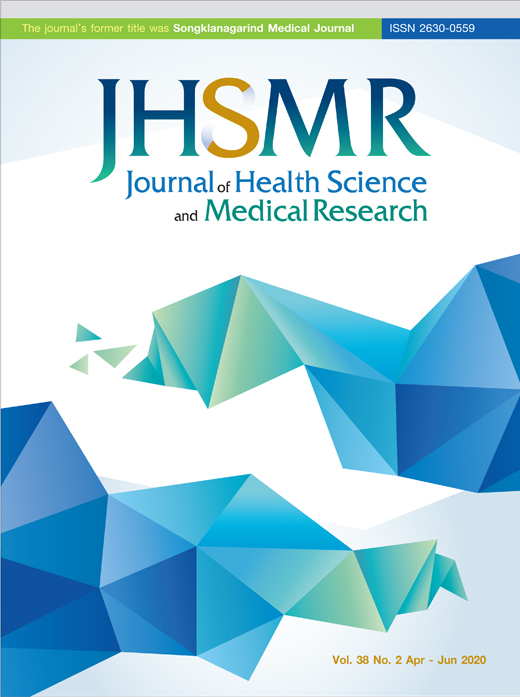Perceived Barrier in Accessing Emergency Medical Services of Ethnic Groups in the Highlands of Chiang Rai Province, Thailand
DOI:
https://doi.org/10.31584/jhsmr.2020731Keywords:
barriers in accessing EMS, emergency medical service, ethnic group, highlandAbstract
Objective: To explore the barriers of accessing emergency medical services among several ethnic groups, including the Hmong, Lisu, Lahu and Akha people.
Material and Methods: The qualitative study was conducted to interview 43 participants, including the Akha, Lahu, Lisu and Hmong people. Purposive sampling was used to select participants for in-depth interviews, from February to March, 2019. The data were analyzed using content analysis.
Results: The results show that the barriers of using emergency medical service (EMS) can be divided into the following five categories: the barrier to effectively communication, response to the symptoms of emergency illnesses, transportation facilities to support patients with emergency illnesses, fear to contact healthcare providers and the individual’s perception of emergency medical symptoms.
Conclusion: The barriers of using EMS among different cultures, ethnicities and languages are a concern and obstacles to the increase appropriate pre-hospital management and reducing pre-hospital delay. A community collaboration partnership should be the goal of improving pre-hospital care among ethnic people.
References
2.Mercuri M, Connolly K, Natarajan MK, Welsford M, Schwalm JD. Barriers to the use of emergency medical services for ST- elevation myocardial infarction: determining why many patients use for self- transport. J Eval Clin Pract 2018;24:375-9.
3.Wandling MW, Nathens AB, Shapiro MB, Haut ER. Association of prehospital mode of transport with mortality in penetrating trauma: a trauma system–level assessment of private vehicle transportation vs ground emergency medical services. JAMA Surgery 2018;153:107-13.
4.Ponsen K, Wachiradilok P, Sirisamutr T, Doungthipsirikul S. The situation and the factors that affect the use of emergency medical services at the emergency department of patient emergency in Thailand [monograph on the Internet]. Nonthaburi: National Institutes of Emergency Medicine Thailand; 2017 [cited 2019 Mar 1]. Available from: https://www.niems.go.th/th/Upload/File/255908171439332756_I7UNTXkvtBfQGYyL.pdf
5.Ibanez B, James S, Agewall S, Antunes MJ, Bucciarelli-Ducci C, Bueno H, et al. 2017 ESC guidelines for the management of acute myocardial infarction in patients presenting with ST segment elevation: the task force for the management of acute myocardial infarction in patients presenting with ST segment elevation of the European Society of Cardiology (ESC). European Heart J 2017;39:119-77.
6.Shatpattananunt B, Wiangosot S, Pintatham K. Elderly patients’ experience in using emergency medical service at a tertiary hospital, upper northern Thailand. Songklanagarind J Nurs 2016;38:102-15.
7.Aringhieri R, Bruni ME, Khodaparasti S, Van Essen JT. Emergency medical services and beyond: addressing new challenges through a wide literature review. Comput Oper Res 2017;78:349-68.
8.Akha tribe in Thailand [homepage on the Internet]. Chiang Rai: The Hill Tribe Organization in Thailand; 2015 [cited 2019 Mar 1]. Available from: http://akha.hilltribe.org/thai/
9.Kunstadter P. Ethnicity, socioeconomic characteristics and knowledge, beliefs and attitudes about HIV among Yunnanese Chinese, Hmong, Lahu and Northern Thai in a north-western Thailand border district. Cult Health Sex 2013;15:383-400.
10.Apidechkul T, Wongnuch P, Sittisarn S, Ruanjai T. Health situation of Akha hill tribe in Chiang Rai Province, Thailand. J Pub Health Dev 2016;14:77-9.
11.Manotham M, Koychusakun P, Choyae A, Maneerat W, Muangmool J, Vanishprinyakul S. Healthcare knowledge and practice of Akha ethnic group: case study at a Mae-mon Village, Tambon Huay-chom-poo, Amphur Muang, Chiang Rai. Res Health Sci 2018;12:111-20.
12.Khungtumneam K. Ethnography research for nursing service system in ASEA. J Roy Thai Arm Nurs 2014;15:29-35.
13.Seng JS, Lopez WD, Sperlich M, Hamama L, Reed Meldrum CD. Marginalized identities, discrimination burden, and mental health: empirical exploration of an interpersonal-level approach to modeling intersectionality. Soc Sci Med 2012;75:2437-45.
14.Santos Jr, Black AM, Sandelowski M. Timing of translation in cross-language qualitative research. Qual Health Res 2015;25:134-44.
15.Squires A. Methodological challenges in cross-language qualitative research: a research review. Int J Nurs Stud 2009;46:277-87.
16.Lincoln YS, Guba E. Naturalistic inquiry. Beverly Hills: Sage; 1985.
17.Sandelowski M, Leeman J. Writing usable qualitative health research findings. Qual Health Res 2012;22:1404–13
18.Kalich A, Heinemann L, Ghahari S. A scoping review of immigrant experience of health care access barriers in Canada. J Immigr Minor Health 2016;18:697-709.
19.Thummapol O, Barton S, Park T. Healthcare access experiences among indigenous women in northern rural Thailand: a focused ethnographic study. Cent Asian J Glob Health 2018;7:328-43.
20.Apidechkul T, Laingoen O, Suwannaporn S. Inequity in accessing health care service in Thailand in 2015: a case study of the hill tribe people in Mae Fah Luang district, Chiang Rai, Thailand. J Health Res 2016;30:67-71.
21.Mould-Millman NK, Rominski SD, Bogus J, Ginde AA, Zakariah AN, Boatemaah CA, et al. Barriers to accessing emergency medical services in Accra, Ghana: development of a survey instrument and initial application in Ghana. Glob Health Sci Pract 2015;3:577-90.
22.Tate RC, Hodkinson PW, Sussman AL. Lessons learned from the application of mixed methods to an international study of prehospital language barriers. J Mix Methods Res 2017;11:469-86.
23.Adeleke A, Apidechkul T, Kanthawee P, Suma Y, Wongnuch P, Pasukphun N. Factors associated with open burning behaviors among Thai and hill tribe farmers in northern Thailand. J Health Res 2017;3:395-402.
24.Kalich A, Heinemann L, Ghahari S. A scoping review of immigrant experience of health care access barriers in Canada. J Immigr Minor Health 2016;18:697-709.
25.Henize AW, Beck AF, Klein MD, Adams M, Kahn RS. A road map to address the social determinants of health through community collaboration. Pediatrics 2015;136:e993-1001.
26.Sultan M, Abebe Y, Tsadik AW, Ababa A, Yesus AG, Mould Millman NK. Trends and barriers of emergency medical service use in Addis Ababa; Ethiopia. BMC Emerg Med 2019;19:1-8.
27.Sungbun S, Piaseu N, Partiprajak S. Needs of stakeholders in fast-track care for ST-segment elevation myocardial infarction (STEMI). Thai J Nurs Res 2018;32:19-38.
28.Sonkong K, Chaiklieng S, Neave P, Suggaravetsiri P. Factors affecting delay in seeking treatment among malaria patients along Thailand-Myanmar border in Tak province, Thailand. Malar J 2015;14:1-8.
























